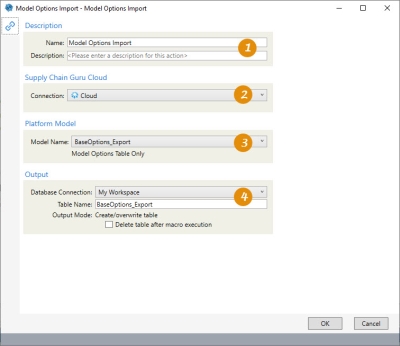Importing model options from the Supply Chain platform
The Platform Model Option Import ![]() action allows you to download and import the model options from a Supply Chain Guru model on the Supply Chain platform to a local database. Before using this action, you must create a Supply Chain Guru Cloud connection to Supply Chain.
action allows you to download and import the model options from a Supply Chain Guru model on the Supply Chain platform to a local database. Before using this action, you must create a Supply Chain Guru Cloud connection to Supply Chain.
When importing model options, you provide:
-
Platform Model - This is the name of the model on the platform.
-
Database Connection - Select the connection to the local database to which the options are imported.
-
Table Name - This is the table in the local database to which the model options are imported.
For example, if you are importing model options:
-
Enter a name and description.
-
Specify connection to Supply Chain platform.
-
Select platform model.
-
Select database connection, local table name, and options. The model options are imported into the local table. A Category Name is displayed to help organize the options.
The most common application is to download data from the cloud to a local database for additional processing.
Model options notes and limitations
-
The Option name in the imported data is a display name, not the back end option name. This is to make it easier to know what the option applies to.
-
At this time, not all options defined for the model are imported. For example, the options controlling the model horizon dates are not currently imported.
-
In some cases, option names result in duplicates. Duplicates are not imported into the local table. This includes the Customer Model Demand and Site Model Demand options. These exist for Network Optimization, Inventory Optimization and Simulation. Only the options for Network Optimization are imported.
-
Some of the options in the Options table of the model do not apply (they may be obsolete or only apply to the desktop product).
A list of the options that are imported and information about valid values is included in the Exporting model options to the Supply Chain platform topic.
Last modified: Thursday December 19, 2024

